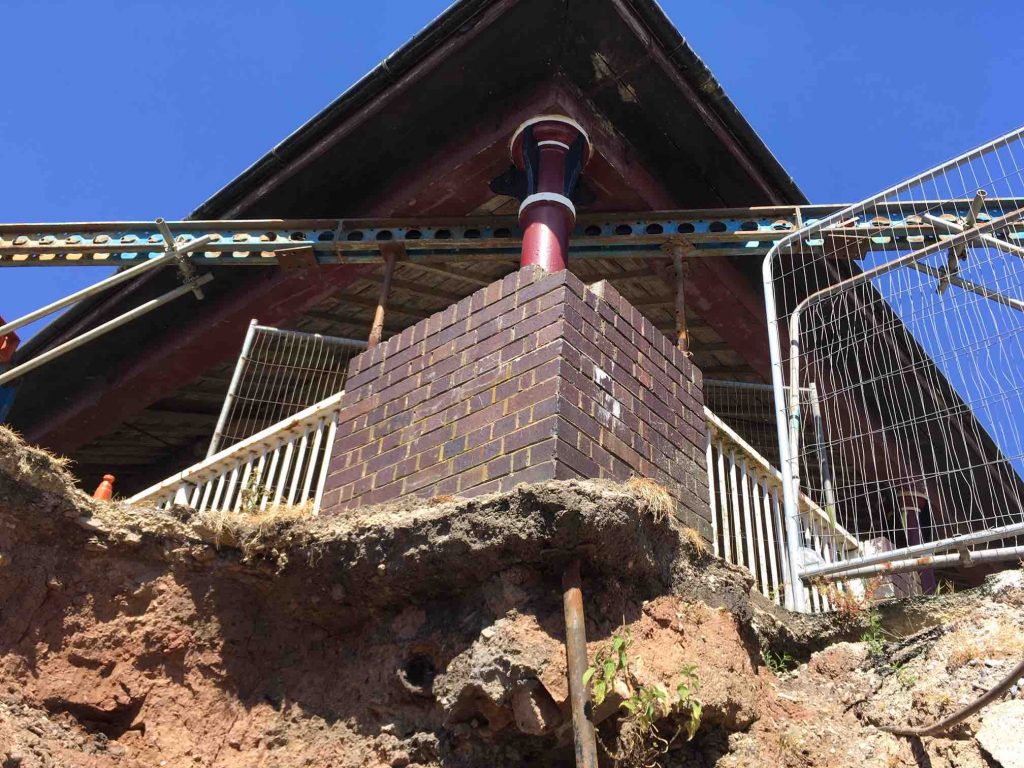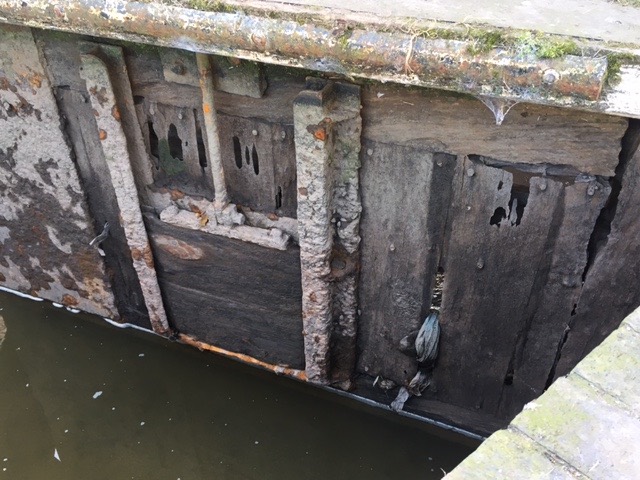The answer is in two parts:
- The Dry Dock has been made unsafe.
- The Dry Dock has been deliberately made commercially unviable.
It must be noted that any modifications to a listed building requires Listed Building Consent. This has not been done here so the work is regarded as unlawful, a criminal offence. Nothing unlawful can be deemed as safe and it certainly can not be operated commercially.
For the reasons mentioned below it is difficult to understand how retrospective Listed Building Consent could ever be granted.
The modifications are unnecessary and have already been carried out. The only solution is to return the listed building back to its original specifications.
The Dry Dock has been made unsafe.
The dry dock is now unsafe because of the modifications made to the discharge culvert and the dry dock lock gates.
Inserting a pipe into the central section of the discharge culvert has created five new safety issues:
- An execution chamber with death by drowning.
- The building is now structurally unsafe.
- No operational control.
- The new plastic pipe will block.
- The work is unlawful.
The replacement of the dry dock lock gates with a modified version has created three further new issues:
- Only one gate sluice.
- No operation control
- The work is unlawful.
1. An execution chamber with death by drowning.
In other words any person falling into the emptying dry dock would be sucked into the culvert and trapped into the entrance of the new pipe and drown. This type of ‘travelling through a culvert’ accident is well known to the canal and river trust. Two incidents that illustrate the dangers of this are the 79 year old woman who survived falling into and passing through an unmodified culvert at Foxton locks. The second being the tragic death of the young Boat Safety Scheme examiner who died, trying to save others, in the modified culvert below Denham Deep lock.
2. The building is now structurally unsafe.
The water in the full dry dock has significant pressure. This water can be released into the 225 year old culvert in a controlled way via the sluice gate. When this sluice gate is fully raised the area of the opening is 470mm by 530mm. The culvert down stream of this sluice gate was originally much larger (man-entry size) prior to the installation of the plastic pipe. This means the discharge water would have been in FREE-flow as it passed down the original culvert.
Installing a 400mm diameter pipe which is significantly smaller (more than 50% smaller) than the sluice opening means the new plastic pipe would be in FULL-flow and under the full dynamic pressure of the water in the dry dock.
This important difference has major implications to safety, blockage and construction (Good practice principal 11.2, page 153 of CIRIA document C786). The installation of the pipe has created a pressurised conduit, often called a pressure culvert (page 6 of CIRIA document C786).
The sluice now has little effect on controlling the flow which is now effectively being governed by the restricting plastic pipe.
When the sluice is opened the area between the sluice and the new pipe is also now under dynamic pressure. Despite the dry dock lock gate contractors only using this sluice a few times this part of the 225 year old structure has now failed. The sluice appears almost impossible to operate and any operator risks the possibility of drowning by the failing condition of the culvert beneath their feet.
The designer of the culvert modification has negligently specified a plastic pipe (Ridgidrain) for a use which is contrary to the manufacturers instructions.
“Ridgidrain is a versatile non-pressure surface water and subsurface water drainage system” – Polypipe Data Sheet.
Ridgidrain should not have been specified for this type of pressure culvert. The product has been deliberately damaged, incorrectly installed with no air-testing of the pipe performed. The pipe will quickly fail if the dry dock is used.
It has been stated that the pipe has only been used as a template to create a hole through the foamed concrete and if it was possible to remove the plastic pipe the culvert would still function. This is of course a dangerously negligent statement as the foamed concrete is neither water proof nor water resistant. The foamed concrete will quickly fail and will certainly be eroded away by the pressure of the water.
The dry dock culvert did not fail while in use. It was allowed to collapse by water coming through and undermining the middle section of the northern sidewall. This caused the collapse of the large stone slabs which form the roof of the culvert. The issue of water leaking from the surrounding canal structures has not been addressed and is still clearly visible today.
Subsidence above the culvert can be seen which is presumably the result of the foamed concrete failing. Clearly any prolonged use of the dry dock culvert would cause a rapid increase in this failure rate.

The dry dock roof is supported on large cast iron columns. One of the corner columns is now being supported by the failing foamed concrete. The resulting ‘disproportionate collapse’ will bring the whole roof down and would result in catastrophic damage to Chester’s gas supply main which runs through (yes through!) the dry dock building.


Foamed concrete is a void filling material, it is not suitable for the construction of a pressure conduit or underpinning work. The designer has tried to negate this negligence by incorporating an Acro-prop to support the roof column.
It is this failing foamed concrete and a single Acro-prop that is now the only thing supporting the dry dock roof.

3. No operational control.
Correctly positioning two narrowboats, often of different lengths and draughts, is a skilled operation. This procedure requires both knowledge and precise control. It is particularly difficult in the dry dock such as we have at Chester where the wind can play a significant role with the precise positioning of the boats. This situation has been greatly exacerbated by the commercial landlord’s recent high-rise property developments which surround the boatyard. Often the water level of the dry dock has to be quickly raised or lowered to avoid damage to both boats and operator. Safely controlling the water discharge rate is essential. This can no longer take place as raising or lowering the dry dock sluice will now have little effect on the discharge rate. If a narrowboat is incorrectly placed onto the support blocks (bostocks) there is a risk for those later working underneath.
4. The new plastic pipe will block.
The plastic pipe is below the minimum size set out in the relevant standard (A1.7 Minimum Culvert Sizes, page 317 of CIRIA document C786). Therefore this undersize plastic pipe will block with debris. This occurred on the second time the new pipe was used!
“The operation was completed by our own site team once they’d installed the new gates; they drained the dry dock a couple of times to ensure everything was in safe working order before they left. On the first occasion it took the expected time to empty but on the second occasion it took them well over an hour to get it drained – once de-watered they found a blockage in the culvert which I am awaiting for photographs to understand what and why this obstruction was in the pipe.” – Richard Spencer, Project Team Leader canal and river trust.
It was not uncommon to see bits of wood and other debris the size of railway sleepers passing out of the original culvert. To clear any substantial blockage now would require the dry dock to be pumped out to gain access. Installing a suitable sized pump has already been dismissed by the canal and river trust. Any attempt to clear a blockage from the quayside risks death by drowning.
Accumulated debris, which previously would have simply travelled through the original culvert, will now require a mechanical hoist and a method of disposal. Any such hoist would require annual testing and suitable road access would need to be provided for debris disposal.
5. The work is unlawful.
None of the modifications made conform to any known standard, guidance, regulation or law. Unlawful or sub-standard work cannot be regarded as safe.
The designers of this project did not inform the relevant outside agencies such as Building Control, the Health & Safety Executive or Historic England of their undertakings. The canal and river trust have repeatedly refused to state their own modifications conform to regulation and are safe!
6. Only one gate sluice.
Replacing the listed dry dock lock gates was long overdue. Both of the lock gates are fitted with a sluice gate, sometimes called a gate paddle. These are used to let water into the dry dock. The mechanism for one gate paddle had failed some time ago and had been removed.


Unfortunately, the canal and river trust decided to modify the replacements lock gates by only installing one of the two original gate sluices.
7. No operational control.
As mentioned above, precise control is required in operating the dry dock. Only having one gate paddle will cause very strong circular currents making precise positioning difficult and hazardous.
8. The work is unlawful.
Normally the replacing of any lock gates would be done on a like-for-like basis. If this had been done here there would have been no need for any listed building consent for this part of the works.
Unfortunately the canal and river trust engineers took the decision to modify these lock gates and just ignoring the requirement for listed building consent. This makes their modifications unlawful and therefore the lock gates are regarded as unsafe.